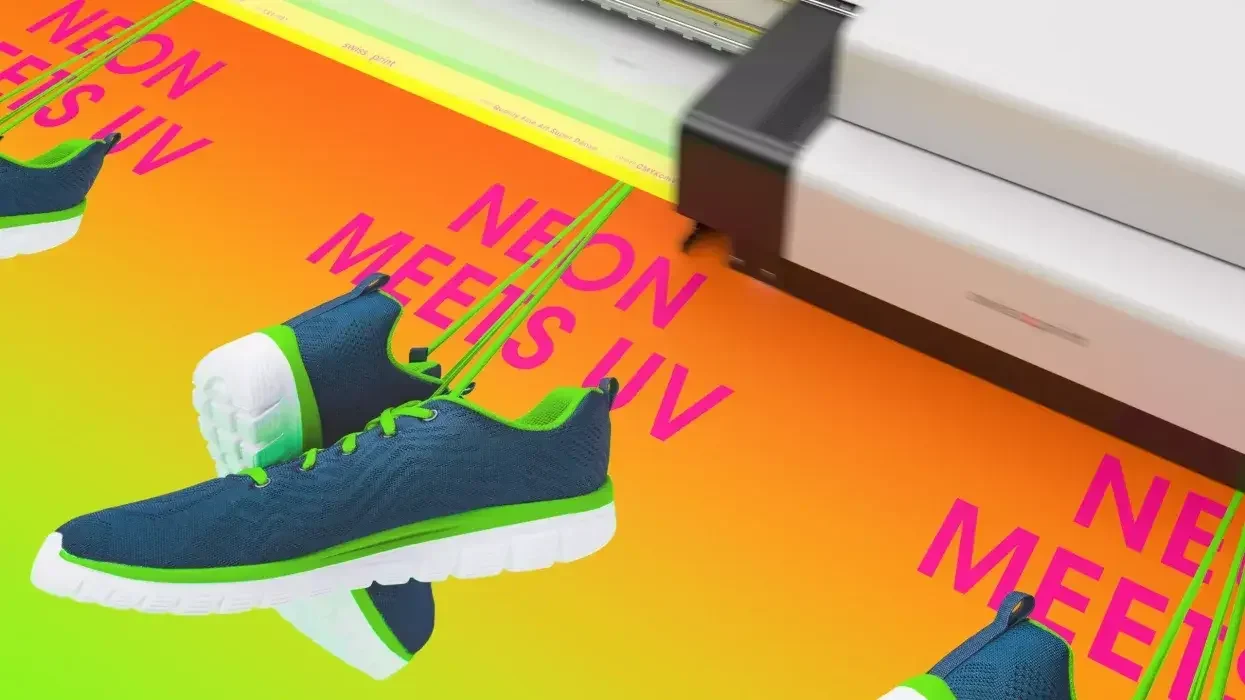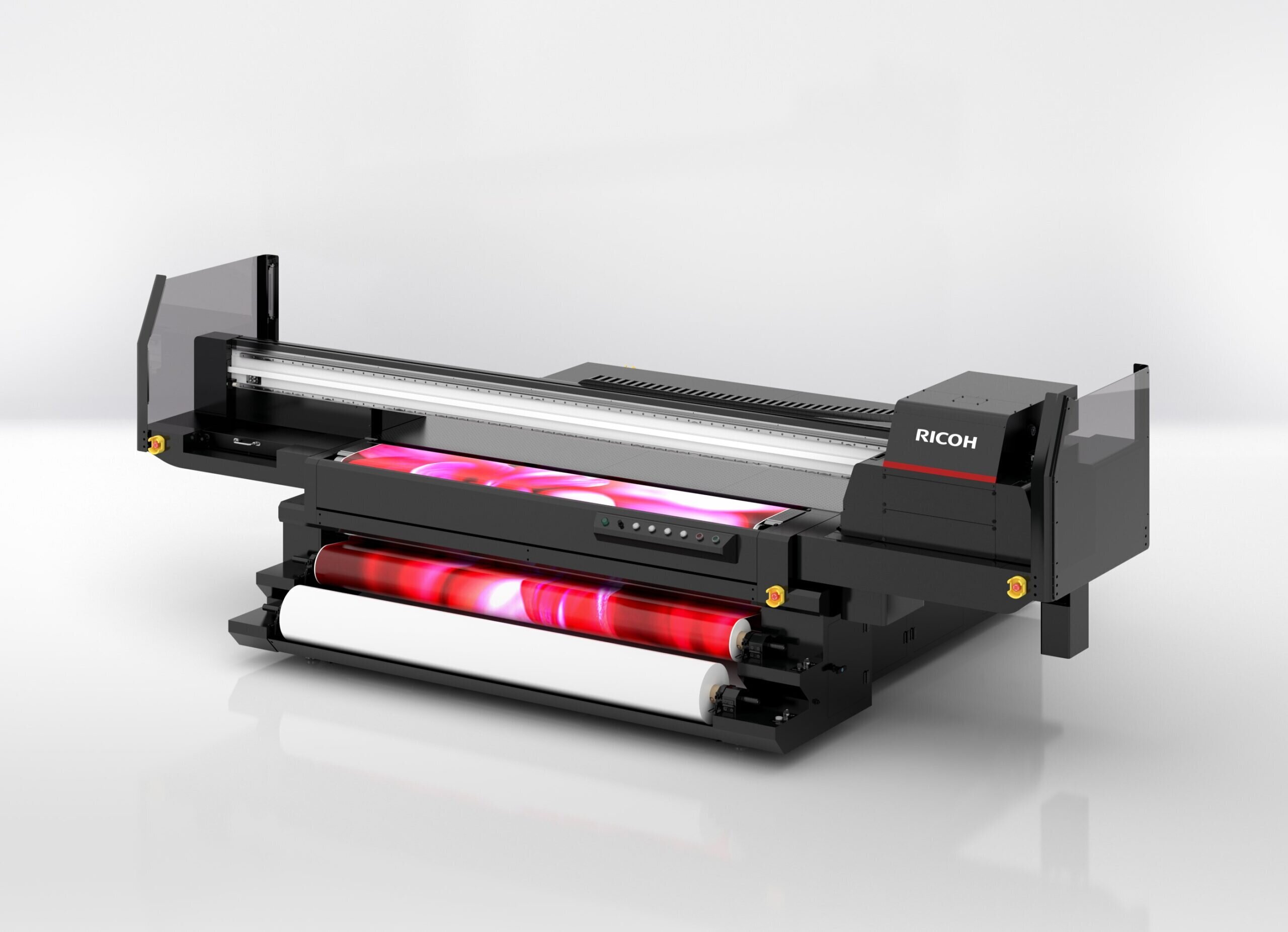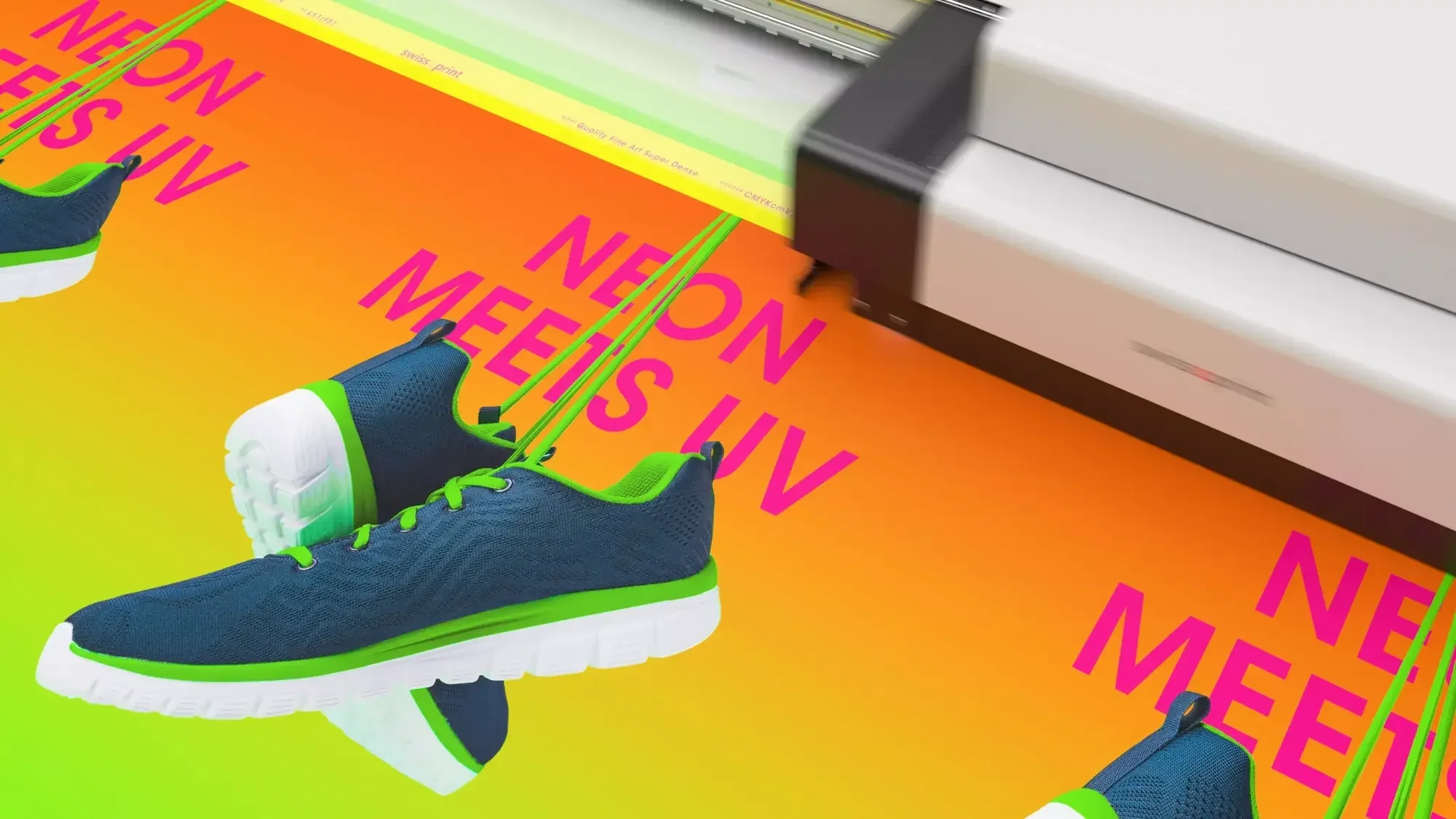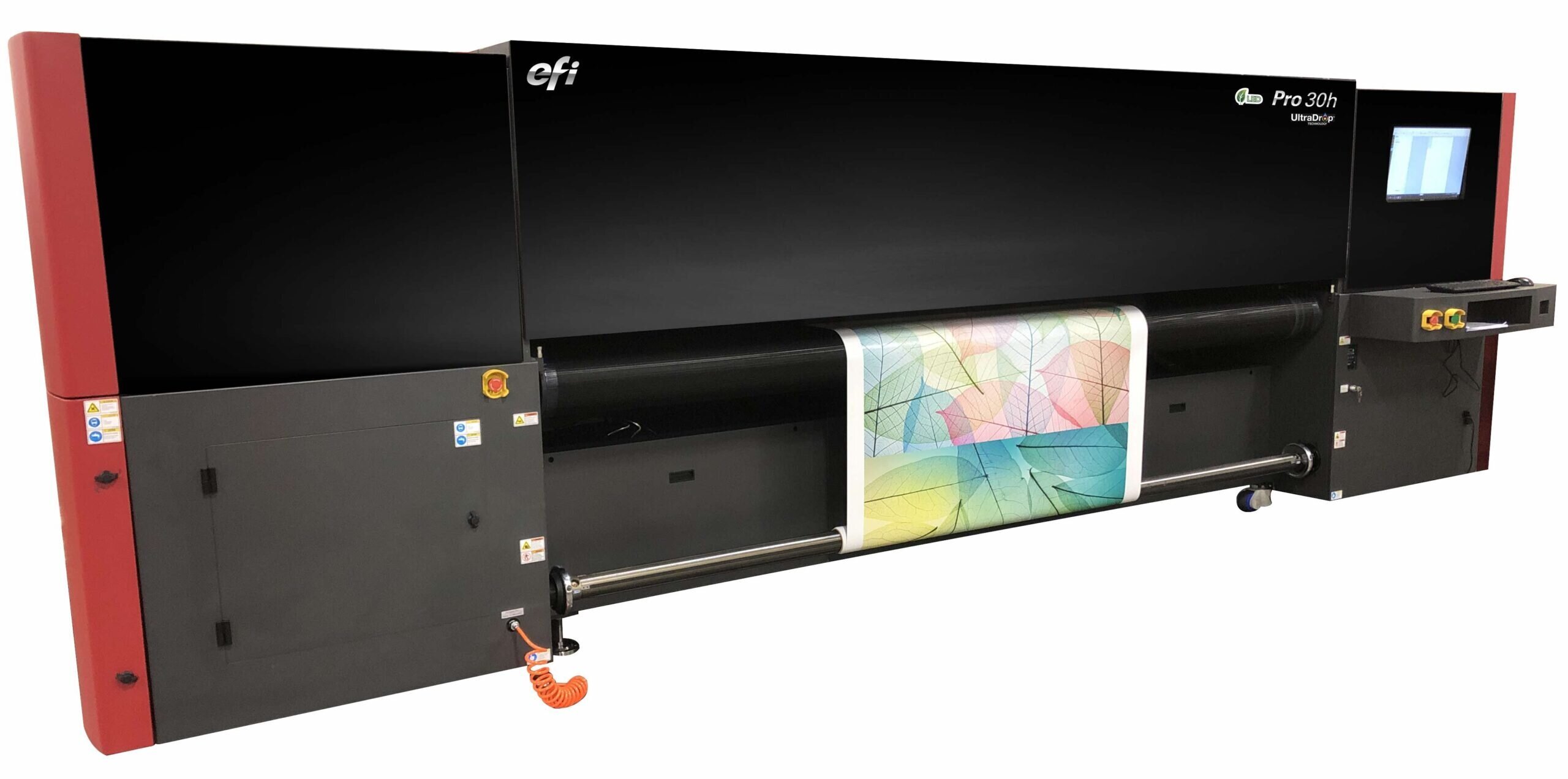
With development in the UV printing technology sector continuing to move forwards at a fast pace, FESPA.com looks at the latest advancements and analyses what these mean for the wider market.
While UV printing technology has been around for some time now, the level of innovation and development in this sector suggests that we can expect more advanced solutions to continue to come to market for years to come.
With that in mind, FESPA.com takes a closer look at some of the latest launches from the leading manufacturers in this market and finds out how these developments will help the user grow their business.
Highly versatile technology
First up, Ricoh has a number of UV print solutions available to the market, the latest coming in the form of the Ricoh Pro TF6251 UV flatbed printer. This 116sq m/hr hybrid includes a roll-to-roll feature that Ricoh said allows greater media versatility and application potential.

Caption: The new Ricoh Pro TF6251 UV flatbed printer includes a roll-to-roll feature that Ricoh said allows greater media versatility and application potential. Image Credit: Ricoh.
“Building on the successful Ricoh Pro TF6250, the hybrid system delivers high productivity with its 12 Ricoh inkjet print heads,” said Sander Sondaal, director of commercial print sales for the graphic communications group at Ricoh Europe said. “On its compact 2.5m x 1.3m sized table, they enable flatbed print speeds of up to 116sq m/hr in four-colour draft mode. For roll print, speeds are up to 67sq m/hr in four colour draft mode.”
The Ricoh Pro TF6251 comes with a choice of two types of inks, the Ricoh DG130 versatile UV ink that offers high adhesion and Ricoh GP120 graphic art UV ink that Sondaal said delivers high colour gamut for greater flexibility.
Other features include an updated user interface that allows for last minute adjustments and simplifies operation with capabilities such as auto material thickness detection, as well as ColorGATE Productionserver Select.
Ricoh also offers the 100sq m/hr Ricoh Pro T7210 UV flatbed printer that can print on areas as big as 2.1m x 3.2m and media up to 110mm media thick. Sondaaladded that specially formulated UV ink has high adhesion properties ideal for a wide range of requirements in signage and decoration.
Key features include an integrated vacuum table with pin registration allowing for the easy positioning of materials that are held firmly in place while printing and a multi-zone vacuum system that can control suction, eliminating the need for masking. There is also full bleed printing that eliminates unnecessary trimming, reducing the time to dispatch the finished job.
“There are a number of advantages of UV printing,” Sondaal said. “UV printing delivers vibrant colours with a sharp crisp finish and almost any surface can be printed as UV ink sits on top of the surface.
“UV print is also scratch resistant and more strongly stands up to wear and tear and sun exposure than traditional printing counterparts, while as the application is dry the moment it comes off the press, there no need to wait for proofing and it can be finished immediately.
“In addition, UV ink is eco-friendly and as the printer is odourless, it means that no special ventilation is required, and it generates only low VOC emissions for the benefit of operators’ health.”
Wide range of applications and markets
Elsewhere and swissQprint mirrors the view that UV printing offers plenty of advantages to users, while the technology can open up a wide range of profitable markets.
“UV printing allows users to produce a wide range of applications because the ink adheres to all manner of materials, while accuracy is excellent thanks to a large colour gamut and low ink consumption means it is cost efficient,” swissQprint said.

Caption: swissQprint has launched a new range of neon inks for UV printing, which it said will allow for the production of eye-catching signage and event applications. Image Credit: swissQprint.
“The technology is also efficient in that postpress processing can begin right after printing as it does not require drying or lamination and is eco-friendly through the use of solvent- and VOC-free inks, with swissQprint’s inks Greenguard Gold certified.”
Looking at the latest UV printing developments from swissQprint, the manufacturer said it will showcase a number of these at the FESPA Global Print Expo in Amsterdam this October. These advancements include the Karibu S speed version of its Karibu UV roll-to-roll printer, which can print sharp images and edges at speeds of up to 330sq m/hr.
The Karibu S features a defined printhead configuration; four print heads are in operation for each process colour, which swissQprint said explains the high throughput rate. It can also handle double-sided printing, include an optimised ink and can handle a wide range of medias.
Also new from swissQprint are neon inks for UV printing, which it said enables eye-catching signage and event applications. These new inks are available in neon pink, yellow, green and orange.
Going green with UV printing
Looking elsewhere and EFI is also of the view that UV printing not only offers a number of major production advantages, but also key benefits when it comes to the environment.
“With decreased power consumption, no bulb replacement and less material waste, EFI UV LED technology provides sustainable advantages,” EFI said. “It eliminates the need for high-power lamps to ensure proper image adhesion and additional heat to evaporate water from printed images.

Caption: The new EFI Pro 30h hybrid flatbed/roll-to-roll printer features UV printing technology. Image Credit: EFI.
“There’s also no warm-up time with instant on/off LED lamps, so print service providers (PSPs) use less energy while increasing uptime and productivity. It also eliminates wasted output associated with uneven curing or colour shifts that often result from mercury bulb degradation. Also, EFI cool cure UV LED technology allows PSPs to print with photo-quality on a wide variety to substrates including recycled materials.
“EFI UV LED inks contain less than .03% volatile organic compounds and are void of heavy metals. They also contain up to 50% monomers and oligomers that are naturally derived from renewable resources, such as plants and biomass.”
EFI is a pioneer in super wide UV LED printing having in 2014 become the first manufacturer to switch to production-speed UV LED for super wide-format printing. Since then, most EFI inkjet printers use UV LED technology, including its latest printers such as the EFI VUTEk Q3r and Q5r super wide roll-to-roll printers and EFI Pro 30h hybrid flatbed/roll-to-roll printer.
“PSPs’ profitability and customer satisfaction hinge on the number of substrates they can print without creating excessive waste,” EFI said. “The combination of LED technology and EFI innovative inks help reduce waste, lower energy use and satisfy more customer demands.”
Multiple production benefits
Kevin Jenner, European marketing manager for wide-format inkjet systems at Fujifilm, was also keen to highlight the green advantages of UV printing, and how these functions can help improve overall production.

Caption: Kevin Jenner, European marketing manager for wide-format inkjet systems at Fujifilm, said the green features of UV printing also help improve overall production.
“UV printing offers reduced environmental impact due to being a solvent-free process and no heaters being required to dry the ink,” Jenner said. “Its unique drying method – UV curing – uses light instead of heat when drying, taking just seconds to harden the inks.
“UV printing therefore allows for faster drying, increasing productivity. As there is no post-curing or degassing process needed, prints are ready for use or further processing. It is also an excellent option for rigid media where users can print direct-to-media rather than printing on roll media and then laminating onto rigid substrates, while it offers excellent scratch resistance.”
This flexibility, Jenner said, allows for printing on virtually any rigid or roll media including plastic, paper, board, wood, metal and glass, thus opening up all sort of markets for users.
With this in mind, he highlighted some of the latest launches from Fujifilm in this segment. These include the Acuity Ultra R2, which Jenner said is focused on maximising return on investment and designed with the user in mind to maintain maximum up-time and exceptional print quality.
Meanwhile, Jenner said the Acuity Prime offers high quality printing on a range of rigid and flexible media, supported by five dedicated vacuum zones and an optional jettable primer, allowing adhesion to more difficult substrates.
In addition, the Onset X HS series includes a range of upgraded features that result in what Jenner described as very high print speeds, optimal machine utilisation, and therefore very high productivity. He added that the Uvijet HM ink range of LED UV curable inkjet inks has been specially developed for use on Fujifilm’s Acuity Prime printers.
“More specifically, the machines offer an automated 30 second job setup time, press uptime and reliability, up to 1,450sq m/hr print speeds and excellent on-the-floor-productivity,” he said.
Going green with UV printing
Finally, Wouter Derichs, sales and marketing director for large-format graphics at Canon Europe, said as UV printing is an ink technology that enables the fastest production speeds and overall most effective workflow, PSPs should consider adding this to their setup.
“UV ink technology has evolved tremendously over the past decade and there is now not a single large-format graphic application that you cannot cover with our UV inks,” Derichs said.
“From completely odourless wall decoration (yes, we have all indoor- and eco certifications) to vehicle graphics and from soft signage backlits to ultra-robust floor graphics and even rigid media like glass, DIBOND, wood and acrylics: our Canon UV portfolio can cover it all.”
With this, Derichs introduced the new Colorado 1630 reel-to-reel printer, based on Canon’s UVgel technology and with a modular setup, allowing users to configure the product to fit their needs. Options include FLXfinish for flexible choice of matte or gloss finish, as well as second media roll and double-sided printing.
Also new from Canon is the Arizona 135GT with roll media option for flexible media, which Derichs said makes the Arizona platform now accessible to a wider audience. Visitors to the FESPA Global Print Expo in October will be able to view both machines first-hand.
“You’ll be surprised about the variety and versatility of applications and solutions that you will see there,” Derichs said. “There is something for everybody: for the beginning sign-maker, making their first steps into digital, up to complete factory solutions.”
“From speaking with some of the leading brands in this market, it is clear that UV printing offers all sort of benefits to users. Be it faster production times or more environmentally friendly printing, adding UV printing kit to your business could be a smart, advantageous move.
Discover the latest innovations in UV printing at the Global Print Expo 2021, Europe’s leading exhibition for screen and digital wide format print, textile printing and signage. Discover the latest products, network with like-minded individuals and explore new business opportunites. Register now and use promo code FESH101 to receive a discount of 30 euros.